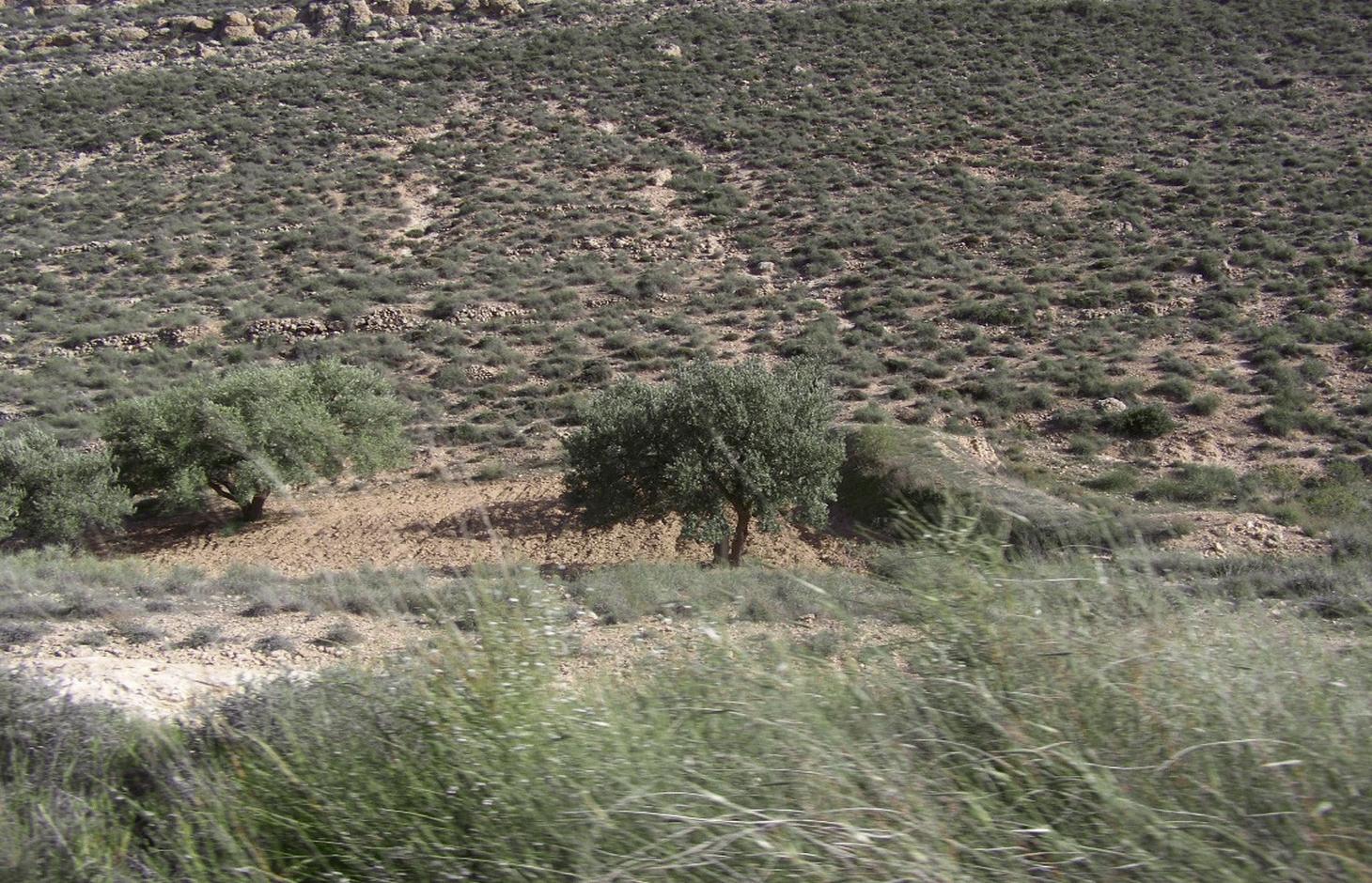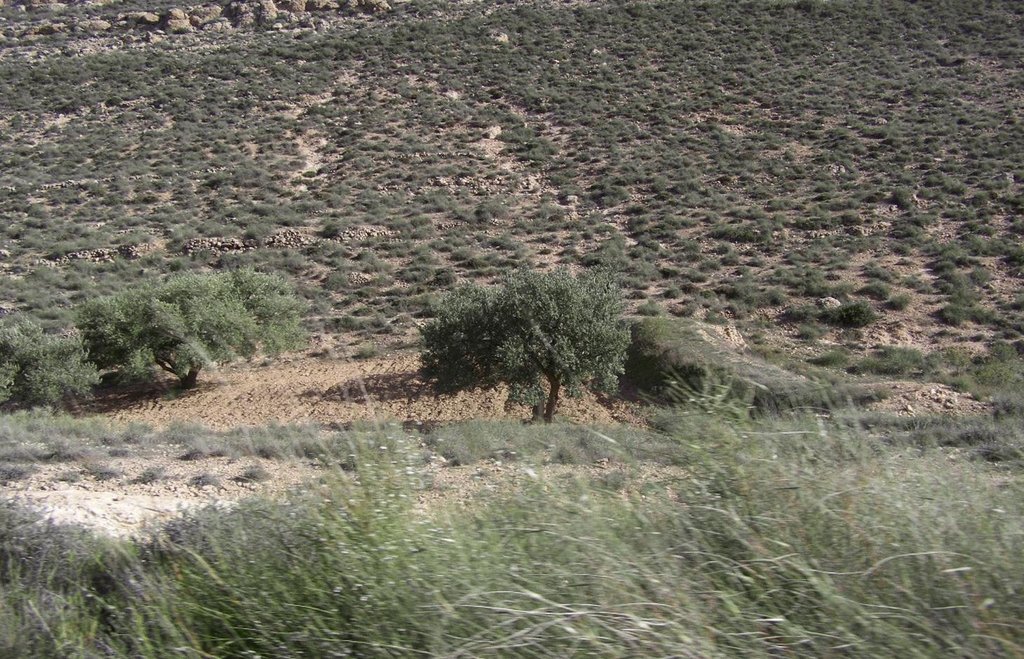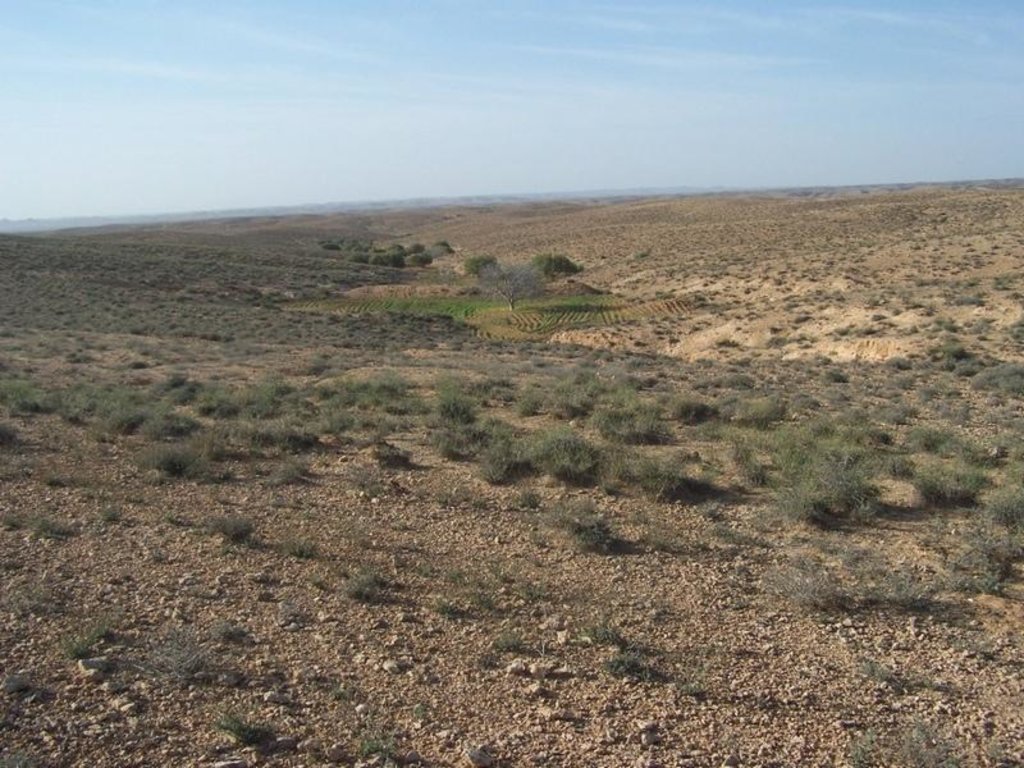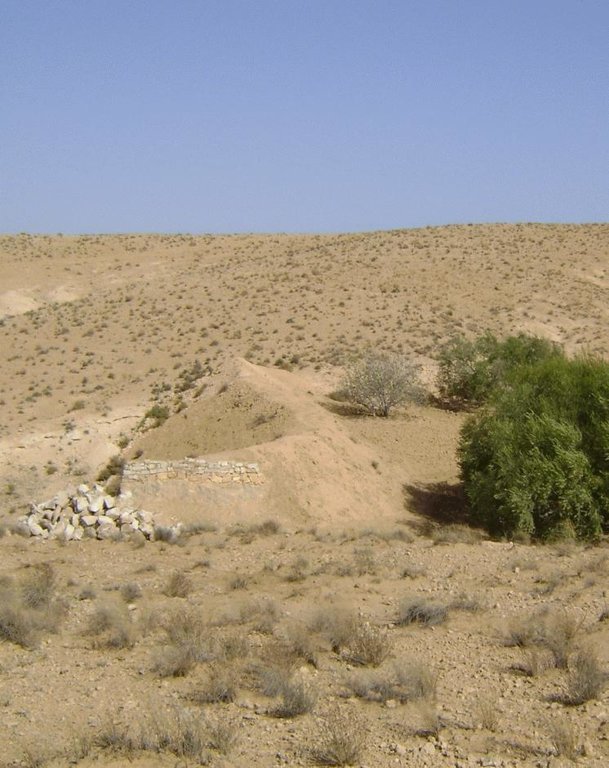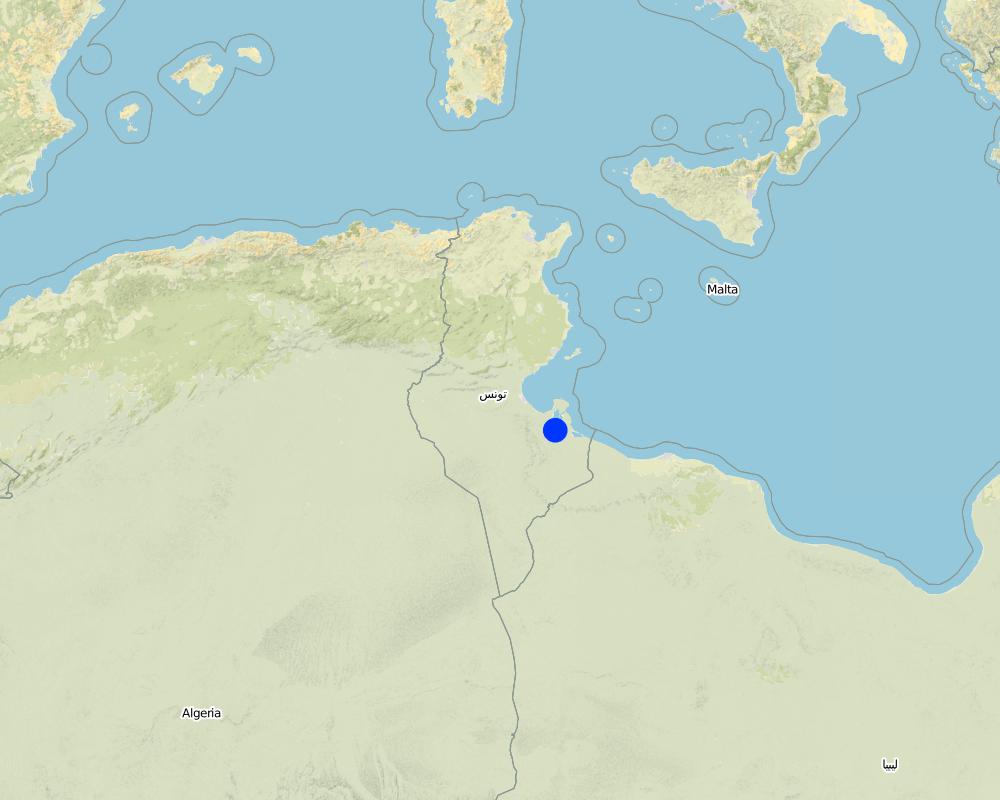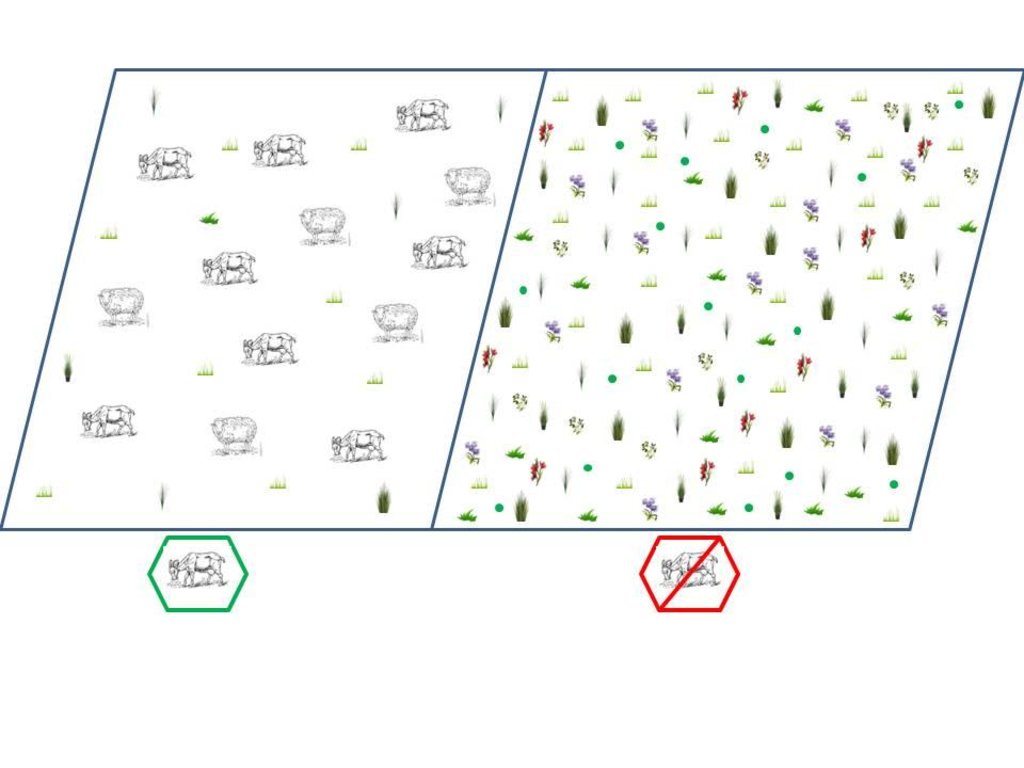Rangelands resting [突尼斯]
- 创建:
- 更新:
- 编制者: Mongi Ben Zaied
- 编辑者: –
- 审查者: Deborah Niggli, Alexandra Gavilano
G'del (Arabic)
technologies_1399 - 突尼斯
查看章节
全部展开 全部收起1. 一般信息
1.2 参与该技术评估和文件编制的资源人员和机构的联系方式
关键资源人
SLM专业人员:
Sghaier Mongi
Institut des Régions Arides IRA
突尼斯
SLM专业人员:
SLM专业人员:
Khatteli Houcine
Institut des Régions Arides IRA
突尼斯
SLM专业人员:
Mliki Salem
Office de l'elevage et des pâturages - OEP
突尼斯
有助于对技术进行记录/评估的项目名称(如相关)
DESIRE (EU-DES!RE)有助于对技术进行记录/评估的机构名称(如相关)
Institut des Régions Arides de Médenine (Institut des Régions Arides de Médenine) - 突尼斯有助于对技术进行记录/评估的机构名称(如相关)
Office de l'élevage et des paturages (OEP) - 突尼斯1.3 关于使用通过WOCAT记录的数据的条件
编制者和关键资源人员接受有关使用通过WOCAT记录数据的条件。:
是
2. SLM技术的说明
2.1 技术简介
技术定义:
This technique is based on the principle of leaving the rangeland protected (by excluding grazing during 2-3 years) to allow the plant cover to recover.
2.2 技术的详细说明
说明:
To tackle degradation and the negative effects of drought on rangelands, leaving the rangeland protected for rehabilitation is one of the common practices used for many decades by local people in arid areas of Tunisia. This technique is based on the principle of not allowing grazing for a period and thus resting the rangeland so that the plant cover can recover. The grazing-free period lasts commonly from 2 to 3 years depending on the ecosystem resilience (its capacity to recover) and climatic conditions. Owing to the high cost of fencing, an agreement between the administration and users is achieved regarding the boundaries (generally making use of natural ones such as a mountain chain, wadi, etc.). Users are totally committed to respect the protection of the site during the fixed period. In return, they receive a subsidy to compensate for the loss of production during this period. It is estimated at a quantity of barley equivalent to 70 US $ per hectare per year.
Purpose of the Technology: Applied in several types of improved land managements (rangeland improvement, dunes stabilization, national parks, etc.), this technique gives good results in terms of regeneration of vegetation in arid and even desert areas of Tunisia. However, the effectiveness of this technique varies according to several factors which determine the potential for regeneration of the treated area (rainfall, soil properties, level of degradation reached, etc.).
Establishment / maintenance activities and inputs: The resting period is recommended even in heavily overgrazed sites, but only if the vegetation still has its resilience capacity (indicated by the presence of some remnants of key and good range species) so that regeneration is possible. To have a fast, substantial and convincing impact, this technique should be applied in those rangelands that still contain relics of good pastoral species and where soil is more or less covered by sediments which allow good infiltration. These wind deposits are used as seed bed and act as mulch. In situations of extreme degradation, there is no point in applying this technique, since in these situations the soil seed stocks are often lacking and/or the soil has reached a very degraded and shallow state.
2.3 技术照片
2.5 已应用该技术的、本评估所涵盖的国家/地区/地点
国家:
突尼斯
区域/州/省:
Medenine
有关地点的进一步说明:
Béni Khédache - El Athmane
具体说明该技术的分布:
- 均匀地分布在一个区域
如果不知道精确的区域,请注明大致覆盖的区域:
- 1-10 平方千米
Map
×2.6 实施日期
如果不知道确切的年份,请说明大概的日期:
- 50多年前(传统)
2.7 技术介绍
详细说明该技术是如何引入的:
- 作为传统系统的一部分(> 50 年)
注释(项目类型等):
The national strategy for rangeland improvement started in 1990.
3. SLM技术的分类
3.2 应用该技术的当前土地利用类型

牧场
粗放式放牧:
- 半游牧畜牧业
- Livestock density (if relevant): > 100 LU /km2
注释:
Major land use problems (compiler’s opinion): degradation of plant cover, loss of plant diversity (mainly perennial species), abundance of unpalatable species, soil erosion.
Major land use problems (land users’ perception): low potential of rangelands, increase in feed costs,
Semi-nomadism / pastoralism: goat and sheep
3.4 供水
该技术所应用土地的供水:
- 雨养
注释:
Number of growing seasons per year:
1
Specify:
Longest growing period in days: 240Longest growing period from month to month: Oct - May
3.5 该技术所属的SLM组
- 区域封闭(停止使用,支持恢复)
- 轮作制度(轮作、休耕、轮垦)
3.6 包含该技术的可持续土地管理措施

管理措施
- M2:改变管理/强度级别
注释:
Main measures: management measures
3.7 该技术强调的主要土地退化类型

土壤水蚀
- Wt:表土流失/地表侵蚀

土壤风蚀
- Et:表土流失

生物性退化
- Bc:植被覆盖的减少
- Bh:栖息地丧失
- Bq:数量/生物量减少
- Bs:质量和物种组成/多样性的下降
注释:
Main type of degradation addressed: Bs: quality and species composition /diversity decline
Secondary types of degradation addressed: Wt: loss of topsoil / surface erosion, Et: loss of topsoil, Bc: reduction of vegetation cover, Bh: loss of habitats, Bq: quantity / biomass decline
Main causes of degradation: overgrazing (Free continous grazing), other human induced causes (specify) (tree and cereal crop expansion, fuel wood collection)
3.8 防止、减少或恢复土地退化
具体数量名该技术与土地退化有关的目标:
- 防止土地退化
- 减少土地退化
注释:
Main goals: mitigation / reduction of land degradation
Secondary goals: prevention of land degradation
4. 技术规范、实施活动、投入和成本
4.1 该技术的技术图纸
技术规范(与技术图纸相关):
Overgrazed (left) and rested (right) rangelands
Date: 2011
Technical knowledge required for field staff / advisors: moderate
Technical knowledge required for land users: moderate
Main technical functions: improvement of ground cover
Secondary technical functions: control of dispersed runoff: impede / retard, increase in organic matter, increase of infiltration, increase of biomass (quantity), Increase of species richness (quality)
Major change in timing of activities: from herding to fencing (rotational grazing)
Control / change of species composition: rangeland resting
Other type of management: supplementary feeding resources
作者:
M. Ouessar
4.2 有关投入和成本计算的一般信息
其它/国家货币(具体说明):
TND
如相关,注明美元与当地货币的汇率(例如1美元=79.9巴西雷亚尔):1美元=:
1.3
注明雇用劳工的每日平均工资成本:
10.00
4.3 技术建立活动
| 活动 | 时间(季度) | |
|---|---|---|
| 1. | Agreement between the rangelands users and the National office of livestock and pasture (OEP) | |
| 2. | Identification and delimitation of the rangelands to be left fallow. |
4.4 技术建立所需要的费用和投入
| 对投入进行具体说明 | 单位 | 数量 | 单位成本 | 每项投入的总成本 | 土地使用者承担的成本% | |
|---|---|---|---|---|---|---|
| 其它 | delimitation rested rangelands | ha | 1.0 | 50.0 | 50.0 | 50.0 |
| 其它 | subsidies (animal feed barely) | ha | 1.0 | 30.0 | 30.0 | 100.0 |
| 技术建立所需总成本 | 80.0 | |||||
| 技术建立总成本,美元 | 61.54 | |||||
4.5 维护/经常性活动
| 活动 | 时间/频率 | |
|---|---|---|
| 1. | Provide subsidies for the owners | Annually |
| 2. | The owner has to guard the rested rangelands (otherwise subsidies can be suspended). | |
| 3. | The owner has to guard the rested rangelands (otherwise subsidies can be suspended). | Annually |
4.6 维护/经常性活动所需要的费用和投入(每年)
| 对投入进行具体说明 | 单位 | 数量 | 单位成本 | 每项投入的总成本 | 土地使用者承担的成本% | |
|---|---|---|---|---|---|---|
| 其它 | subsidies (animal feed barely) | ha | 1.0 | 70.0 | 70.0 | 100.0 |
| 技术维护所需总成本 | 70.0 | |||||
| 技术维护总成本,美元 | 53.85 | |||||
注释:
The subsidies (barely) are fully provided by the government in the framework of the national strategy.
5. 自然和人文环境
5.1 气候
年降雨量
- < 250毫米
- 251-500毫米
- 501-750毫米
- 751-1,000毫米
- 1,001-1,500毫米
- 1,501-2,000毫米
- 2,001-3,000毫米
- 3,001-4,000毫米
- > 4,000毫米
有关降雨的规范/注释:
6 months of dry period
农业气候带
- 干旱
Thermal climate class: subtropics
5.2 地形
平均坡度:
- 水平(0-2%)
- 缓降(3-5%)
- 平缓(6-10%)
- 滚坡(11-15%)
- 崎岖(16-30%)
- 陡峭(31-60%)
- 非常陡峭(>60%)
地形:
- 高原/平原
- 山脊
- 山坡
- 山地斜坡
- 麓坡
- 谷底
垂直分布带:
- 0-100 m a.s.l.
- 101-500 m a.s.l.
- 501-1,000 m a.s.l.
- 1,001-1,500 m a.s.l.
- 1,501-2,000 m a.s.l.
- 2,001-2,500 m a.s.l.
- 2,501-3,000 m a.s.l.
- 3,001-4,000 m a.s.l.
- > 4,000 m a.s.l.
关于地形的注释和进一步规范:
Altitudinal zones: 101-500 m a.s.l. (Dahar plateau rangelands)
5.3 土壤
平均土层深度:
- 非常浅(0-20厘米)
- 浅(21-50厘米)
- 中等深度(51-80厘米)
- 深(81-120厘米)
- 非常深(> 120厘米)
土壤质地(表土):
- 粗粒/轻(砂质)
- 中粒(壤土、粉土)
表土有机质:
- 低(<1%)
如有可能,附上完整的土壤描述或具体说明可用的信息,例如土壤类型、土壤酸碱度、阳离子交换能力、氮、盐度等。:
Soil fertility is: very low
Soil drainage / infiltration is: medium
Soil water storage is: low
5.4 水资源可用性和质量
地下水位表:
> 50米
地表水的可用性:
匮乏/没有
水质(未处理):
不良饮用水(需要处理)
关于水质和水量的注释和进一步规范:
Availability of surface water: Poor/none (surface water is limited by rainfall) or medium (in the mountain area)
5.5 生物多样性
物种多样性:
- 中等
关于生物多样性的注释和进一步规范:
Biodiversity is medium in the mountain areas and low in the others
5.6 应用该技术的土地使用者的特征
生产系统的市场定位:
- 混合(生计/商业)
非农收入:
- > 收入的50%
相对财富水平:
- 贫瘠
- 平均水平
个人或集体:
- 个人/家庭
性别:
- 男人
说明土地使用者的其他有关特征:
Land users applying the Technology are mainly common / average land users
Difference in the involvement of women and men: Genrally, the outside house work is performed by men.
Population density: < 10 persons/km2
Annual population growth: < 0.5%
10% of the land users are rich and own 20% of the land.
70% of the land users are average wealthy and own 60% of the land.
20% of the land users are poor and own 20% of the land.
Off-farm income specification: Off-farm incomes come from migration, construction works, commerce, tourism sector, administration or informal activities.
5.7 应用该技术的土地使用者使用的平均土地面积
- < 0.5 公顷
- 0.5-1 公顷
- 1-2 公顷
- 2-5公顷
- 5-15公顷
- 15-50公顷
- 50-100公顷
- 100-500公顷
- 500-1,000公顷
- 1,000-10,000公顷
- > 10,000公顷
这被认为是小规模、中规模还是大规模的(参照当地实际情况)?:
- 小规模的
5.8 土地所有权、土地使用权和水使用权
土地所有权:
- 社区/村庄
- 个人,有命名
土地使用权:
- 社区(有组织)
- 个人
用水权:
- 社区(有组织)
- 个人
5.9 进入服务和基础设施的通道
健康:
- 贫瘠
- 适度的
- 好
教育:
- 贫瘠
- 适度的
- 好
技术援助:
- 贫瘠
- 适度的
- 好
就业(例如非农):
- 贫瘠
- 适度的
- 好
市场:
- 贫瘠
- 适度的
- 好
能源:
- 贫瘠
- 适度的
- 好
道路和交通:
- 贫瘠
- 适度的
- 好
饮用水和卫生设施:
- 贫瘠
- 适度的
- 好
金融服务:
- 贫瘠
- 适度的
- 好
6. 影响和结论性说明
6.1 该技术的现场影响
社会经济效应
生产
饲料生产
饲料质量
畜牧生产
生产区域
收入和成本
农业收入
社会文化影响
食品安全/自给自足
国家机构
SLM/土地退化知识
冲突缓解
Improved livelihoods and human well-being
注释/具体说明:
Combat the rural exodus and improve the income of agriculture (20%)
生态影响
土壤
土壤覆盖层
土壤流失
土壤有机物/地下C
生物多样性:植被、动物
生物量/地上C
植物多样性
害虫/疾病控制
注释/具体说明:
increased niches for pests : negligible (0-5%)
6.2 该技术的场外影响已经显现
下游洪水
风力搬运沉积物
对公共/私人基础设施的破坏
6.3 技术对渐变气候以及与气候相关的极端情况/灾害的暴露和敏感性(土地使用者认为的极端情况/灾害)
气候有关的极端情况(灾害)
气象灾害
| 该技术是如何应对的? | |
|---|---|
| 局地风暴 | 好 |
气候灾害
| 该技术是如何应对的? | |
|---|---|
| 干旱 | 好 |
水文灾害
| 该技术是如何应对的? | |
|---|---|
| 比较和缓的(河道)洪水 | 好 |
注释:
Without human disturbance, natural vegetation is well adapted to drought.
6.4 成本效益分析
技术收益与技术建立成本相比如何(从土地使用者的角度看)?
短期回报:
积极
长期回报:
非常积极
技术收益与技术维护成本/经常性成本相比如何(从土地使用者的角度看)?
短期回报:
积极
长期回报:
非常积极
6.5 技术采用
在所有采用这项技术的人当中,有多少人是自发的,即未获得任何物质奖励/付款?:
- 0-10%
注释:
98% of land user families have adopted the Technology with external material support
2% of land user families have adopted the Technology without any external material support
There is a moderate trend towards spontaneous adoption of the Technology
6.7 该技术的优点/长处/机会
| 土地使用者眼中的长处/优势/机会 |
|---|
|
Reduce the costs of supplementation of livestock How can they be sustained / enhanced? subsidies of the goverment |
| 编制者或其他关键资源人员认为的长处/优势/机会 |
|---|
|
Traditional technology - not expensive How can they be sustained / enhanced? by the participation of the land user's |
6.8 技术的弱点/缺点/风险及其克服方法
| 土地使用者认为的弱点/缺点/风险 | 如何克服它们? |
|---|---|
| Limitation of the grazing area | subsidies from the government and/or reduce animal numbers. |
| 编制者或其他关键资源人员认为的弱点/缺点/风险 | 如何克服它们? |
|---|---|
| Heavily based on government subsidies | alternative feed, rangeland seeding, etc. |
7. 参考和链接
7.1 信息的方法/来源
7.2 参考可用出版物
标题、作者、年份、ISBN:
Ouled Belgacem A., Papanastasis V. 1995. Impact of Grazing practices on rangeland vegetation of western Crete. Cah. Options Méditerr. ISSN: 1022-1379. vol.12: 209-212
可以从哪里获得?成本如何?
IRA , CIHEAM
标题、作者、年份、ISBN:
Ouled Belgacem A., Chaieb M., Neffati M., Tiedeman J. 2006. Response of Stipa lagascae R. & Sch. to protection under arid condition of southern Tunisia. Pakistan Journal of Biological Science. 9(3):465-469.
可以从哪里获得?成本如何?
IRA
标题、作者、年份、ISBN:
Ouled Belgacem, A., Ben Salem H., Bouaicha A., El Mourid Mohamed. 2008. Communal rangeland rest in arid area, a tool for facing animal feed costs and drought mitigation: the case of Chenini community, southern Tunisia. J. Bio. Sc., 8(4): 822-825.
可以从哪里获得?成本如何?
IRA
标题、作者、年份、ISBN:
Ouled Belgacem A., Zaafouri M.S. 1996. Impact de la privatisation des terres de parcours collectives sur la végétation pastorale en zones désertiques Tunisienne. Option Médit. Serie A: Séminaires Méditerranéens, n° 32: 213-217.
可以从哪里获得?成本如何?
IRA, CIHEAM
链接和模块
全部展开 全部收起链接
无链接
模块
无模块


